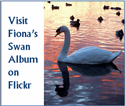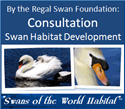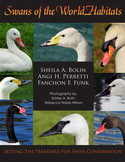Ask the Swan Specialist
Date: 9 February 2013
Hi Connie:
Your situation is not an unusual one. Golf courses, hotels, resort, public facilities and even private facilities set out with a pair of mating swans and before they know it they are overrun with new cygnets from year to year with no end in sight.
We do not know what species of swans you are dealing with, but most captive settings use the Mute or Black Swans. So, we will answer this quesitons with these two species in mind.
If the swans are of these species, then many states consider them exotic pets (non-native) and the owner is responsible for all veterinary care and daily humane treatment. Basically, the owner is a zoo owner. This means that the birds MUST be pinioned so that they cannot fly to form a feral population in the wild. To do so, most state wildlife entities will charge the owner $500 per flying bird and the cost of the bullet and manpower to kill them so that they cannot reproduce in the wild.
If the species of swans are other than these two species, they may be considered wild swans and your facility may need special permits.
Once pinioned if performed correctly, the swans SHOULD NOT be able to fly twenty feet. They should only skim the water as you state. Now, having said this, we have seen improperly pinioned swans able to circumvent the pinioning by shifting their weight onto their non-pinioned wings to get lift to fly a short distance.
In any case, a pinioned swan CANNOT protect itself from predators. By state law, if you own this animal, you are responsible for its protection. So, if you know that coyotes are in the area, you are required to protect them from predation. Again, the habitat must provide humane treatment and veterinary medical care.
Humane treatment means adequate and ample food for each bird in the habitat. This means daily supplemental feeding (at will for the birds using a system such as the Blitz or Dog Cafe feeder which allows the birds to eat at will and keeps predators and pests (raccoons, other birds) from eating the food. The food is a 1/2 mix of poultry layer pellet and 1/2 cracked corn. Lettuce can also be added to provide supplemental vegetation.
A Mute swan can eat up to 2-3 pounds of food (including aquatic vegetation) daily. A Black Swan eats slightly less due to its smaller size.
Mute Swans produce a brood of 1-10 cygnets a year (producing once a year) while the Black Swan can produce 1-8 cygnets (twice a year).
This is the reason that we strongly suggest that entities use same gender swans (two males or two females) which cannot produce. Since you have 35 swans and they probably have already paired, it would be inhumane to separate the breeding pair. The solution would be to find homes for several of the mating pairs to reduce the number of cygnets.
You can receive money for the sell of cygnets, however, THIS IS GOING TO BE A MAJOR ISSUE for your facility. Your facility will now become a BREEDER which will require possible permitting from your local Fish & Wildlife Commission. This breeder status will provide an even bigger headache for you because you will need to keep copious records and logs regarding births and deaths, you will need a critical care wildlife plan (in the event of a natural or man-made disaster), pinioning and records of such pinioning at 1-3 weeks of age (veterinary costs associated), records of lineage (parents), veterinary records (any vaccinations, treatments and other care provided) to ensure that the swans are healthy prior to your giving them or selling them to another site. So, you can see, that addling of swan eggs may not be the worst possible solution because it prevents future generations.
We hope this information is of benefit to you. If you need further assistance, please do not hesitate to contact us. We also just published a new book: (Swans of the World Habitats: Setting the Standard for Swan Conservation) which you can order a copy at (www.theregalswan.com). The book will provide all swan habitat owners and swan owners with essential information required for designing, developing and implementing a humane habitat for swans. The Regal Swan
Messages In This Thread
- Questions about captive mute swans -- connie -- 7 February 2013
- Re: Questions about captive mute swans -- The Regal Swan -- 9 February 2013
- Re: Questions about captive mute swans -- connie -- 10 February 2013
- Re: Questions about captive mute swans -- The Regal Swan -- 10 February 2013
- Re: Questions about captive mute swans -- connie -- 10 February 2013
- Re: Questions about captive mute swans -- The Regal Swan -- 9 February 2013
Ask the Swan Specialist is powered by
Tetra-WebBBS 5.30 Beta © 2006-2007 Tetra-Team






